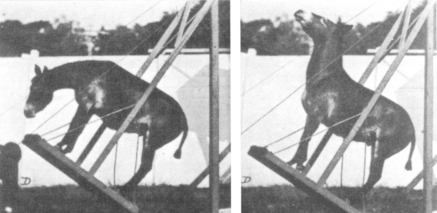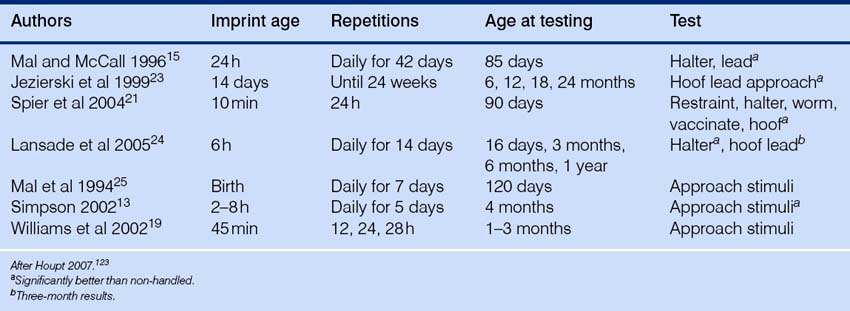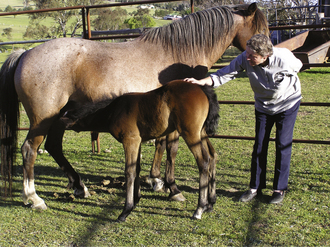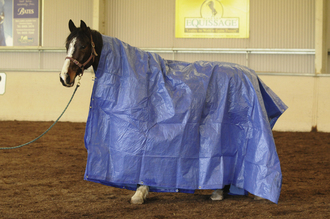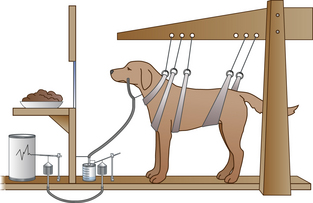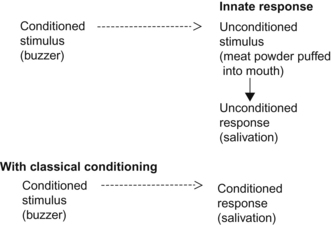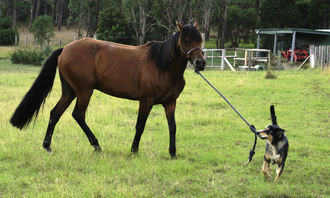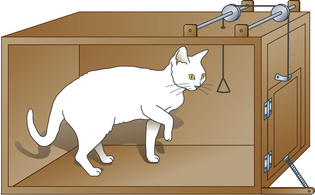Chapter 4 Learning
Learning theory
Equids can learn remarkable behavioral responses (Fig. 4.1), but if we are to consider principles in horse-training from a rigorous scientific perspective, there is an abiding need to demystify traditional horse-training jargon and couch the following discussion in the language of learning theory. This unifying language explains what happens at a mechanistic level in all effective training systems.1 Using this approach veterinarians and equine scientists can be agents of change by counseling owners and trainers on effective and humane techniques in training and retraining. A glossary of equestrian terms appears at the end of this book, so this chapter avoids any such esoteric labels. The original rules of what we call learning theory were first set down by psychologists and behaviorists who used clinically controlled, some would say sterile, stimuli. These days the study of animal learning is increasingly the pursuit of cognitive ethologists. These are the behavioral scientists who, when considering the way in which a member of a species processes information, emphasize the importance of the environment for which that species evolved and determine how the biology of a species can influence its behavior.2
The definition of learning
Not all changes in behavior are consequences of learning. The reference to a ‘relatively permanent change’ is added to exclude modifications of behavior by motivational factors, physiological variables or fatigue. A thirsty horse that drinks despite having refused water some hours earlier has changed its behavior but is not considered to have learnt anything in the interim. Instead, its motivation to drink has changed as a result of shifts in variables such as blood volume and the concentration of sodium in body fluids. Similarly, fatigue can change behavior, transforming a rearing colt into a weary slug, but its effects could not be described as relatively permanent.
Sufficient reflexive responses cannot possibly be built into each foal to meet every challenge throughout life, so learning enables young horses to use their experience to update their behaviors according to their developing circumstances. Although only cursorily studied in any empirical sense, it is likely that horses are particularly attentive when learning to do what they fill most of their days with – grazing. Foals sample their mothers’ feces when learning to select safe vegetation types, while adult horses retain the ability to review preferences in diet according to the proximate consequences of consumption.3
Intelligence
The intelligence of animals is difficult to assess. Intelligence may be shown when the animal learns to ignore irrelevant stimuli, just as it also learns to react to significant stimuli. This permits the behavioral developments that make discrimination possible. The horse’s integration with its domestic environment is facilitated by this ability to compare and contrast. Most horses can accurately discriminate between stimuli and evaluate them, e.g. they can differentiate sounds, visual features of special significance, the identities of people, and so on.4
Several attempts have been made to compare learning abilities in horses with those of other species and to compare the ability of different breeds of horses.5,6 All of the tests between species are confounded by the differences in physical ability and sensory acuity between species, as these may account for the differences in perceived ‘intelligence’. Add to this the species’ differences in motivation and the variation in salience of a single type of apparatus and one begins to see how such comparisons are inherently flawed. One can see how difficult it is to devise a test that two species can undertake with equity. Experimenters have yet to make the necessary adjustments to stimuli so that members of two species can detect and respond to them with equal ease, speed and motivation. The same criticism can be leveled at experiments that compare the problem-solving ability of breeds within a species or, for that matter, bloodlines within a breed.7 Selection of breed traits can impair or enhance performance in various ways, including emotionality.
Imprinting and socialization
Some neonate animals show evidence of imprinting in a special category of learning that occurs during a highly sensitive period in their development, generally at the time of their first stimulation from the outside world. Spalding8 was the first to make systematic observations of this phenomenon, reporting that shortly after hatching, young chicks followed any moving object. Later, Lorenz9 made the topic popular among behavioral scientists. He described imprinting as a unique process in precocial birds occurring exclusively in a sensitive period during which 2–3-day-old hatchlings begin to studiously follow a ‘mother figure’. Typically, this figure is the hatchlings’ real mother, but Lorenz recognized that, during their growth period, they would follow almost any moving object. Lorenz posited that imprinting was irreversible and, given that birds hatched by another species often court and attempt to mate with the foster species, that it determined future mating partners.
For equine practitioners, the questions are: does imprinting occur in horses; and, if so, is it the same as in precocial birds; and is it of any use in training and management? Veterinarian Robert Miller10 introduced the term imprinting to describe the behavior of young foals and suggested that the sensitive period for foals, when the ‘following response’ is learned, is within the first 48 hours of life. At this time the foal’s mother is usually the nearest large moving creature in its world and it is to her that the foal bonds.
Imprinting is mediated by the sense of sight, but sound and olfaction are also involved. Having described imprinting as a process in foals, Miller also introduced the prospect of imprint training as a viable methodology for modifying the behavior of newborn foals in a bid to reduce the prevalence of aversive reactions and defensive aggression while at the same time sensitizing the foal for pressure release.10,11 Miller’s observations about the phenomenon of imprinting are noteworthy, because like gallinaceous birds, horses are precocial and are mobile soon after birth. If Miller’s claims are correct, we should spend time imprint training foals rather than schooling larger, stronger and more dangerous youngsters.
The increase in popularity of imprint training over recent years has triggered interest in the process from scientists, not least because of the possible implication of flooding and learned helplessness in techniques revolving around restraint and aversive stimuli. The ensuing research suggests significant limitations to Miller’s schema. Concerns have been raised for the wellbeing of foals that undergo significant human interventions shortly after birth. Henry et al12 noted that foals separated from their dams for just one hour went on to show patterns of strong dependence on their mothers, little play, social withdrawal and aggressiveness. The perceived need for persistence in application of restraint as part of the Miller regime remains a contentious issue. Restraint may increase latency to stand, but such delays are not accompanied by any accompanying increase in the latency to nurse.13 However, because restraint of struggling foals may increase their risk of injury, veterinarians should consider this outcome carefully before advocating the Miller system. Similarly, as we shall see, they should be mindful that there is insufficient evidence to demonstrate that handling at later ages could not have similar results.14
The sensitive period during which foals can acquire any special learning remains elusive. Mal & McCall15 concluded that handling throughout the first 42 days of life improved performance in a halter-training task compared with handling from days 43 to 84. Concurring with Miller about the likely existence of a critical period, they suggested that this period lies within the first 42 days of life.
Heird et al16 reported that when moderately handled from weaning until 18 months of age, foals showed enhanced problem-solving abilities. Extensively handled horses were slower navigating through a maze than minimally handled horses, but faster than unhandled horses. That said, we should consider the possibility that the aversiveness of confinement within the maze was greatest in the unhabituated, unhandled foals and that problem-solving in and therefore progress through the maze may have been hampered simply by fear. On the other hand, the extensively handled horses, having been trained to wait for cues, may have been more dependent on human signals to advance through the maze. Heird et al16 also reported that horses which had been extensively handled were less emotional, showed a higher maze-learning performance and were more trainable for riding than those that had received less early handling. This evidence supports handling protocols that reduce flight response through habituation, approaches that do not necessitate imprint training per se.
Most of the recent literature suggests that imprint training of foals does not correspond to any natural analogue in the equid ethogram and that, during imprint training, the foals frequently resist strongly and are distressed.17 Whether this early stress can be justified in terms of later benefits is still subject to debate.18 Williams et al19,20 showed that handling foals at birth and/or 12, 24 and 48 hours after birth, had no beneficial effect on their later behavior when tested at 1, 2 and 3 months of age19 or at 6 months of age.19,20
The distinctions among habituation, any equine analogue of filial imprinting (as described in birds) and the more radical elements recommended by Miller are far from simple. This explains why some studies have shown some positive effects of imprint training. For example, foals handled early tend to approach familiar humans12 and accept foot handling21 more readily than unhandled ones. However, aversive stimuli were not rendered more tolerable by imprint training. For example, at 3 or 4 months of age, fitting halters or clipping was as disturbing for handled foals as it was for unhandled foals.13,19,21 Significantly, foals that had been imprinted and then went without regular later handling were as difficult to approach as controls22 (Table 4.1).
Handling after the putative sensitive period seems to have only transient benefits.24 While Mal et al25 found no beneficial effects when foals were handled (stroking, haltering or picking up feet) during the first 7 days, subsequent evidence has emerged to suggest that, when subjected to similar handling at 14 days of age, foals were more tractable at 3 months than non-handled foals. However, differences between the handled and unhandled foals were less apparent when tested at 6 months of age and had disappeared completely by one year of age.22
Higher trainability16 and easier handling,26 has been reported in foals handled regularly from weaning. Similarly, Hausberger et al18 proposed that any benefits of early handling rely on regular repetitions of handling. Compared with unhandled foals, handling foals 5 days per week (including catching, leading, picking up feet, grooming and being approached by an unfamiliar human) until they are 2 years of age improved manageability at 12, 18 and 24 months.23 The optimal duration of the handling period is still unclear, but the optimal time for handling seems to be at weaning since, in contrast to imprint training, this would reduce the chance of interfering with the mare–foal bond. It should be followed up with regular handling.
Hausberger et al18 point out the absence of evidence in foals for the existence of a sensitive period in development that assists in the formation of a foal–human bond. They emphasize that the affiliative qualities of human–horse interactions may be more important than when the interactions occur. Certainly, prior to weaning, foals seem to find being scratched highly reinforcing and humans may be better at scratching some body parts than other horses are.2 In a similar vein, Søndergaard & Halekoh27 proposed that unhandled 2-year-olds become as familiar as handled animals, probably because humans bring food.
Given that foals learn from their dams, it is worth noting that the reactions of the mare during handling have an impact on the foal’s behavior. Sigurjonsdottir & Gunnarsson22 found that the mare’s nervousness correlated positively with the imprinted foal’s resistance to capture, haltering and leading at the age of 4 months. In essence, they demonstrated that the calmer the mare, the easier the foal was to handle. This finding could simply reflect social learning or the inheritance of flightiness. However, more direct activities, such as brushing and hand-feeding of the mare in the presence of the foal had a lasting, positive effect.28 One year later, without any handling in the interim, foals handled in this way were more easily approached in the paddock and stroked by a familiar or unfamiliar human, whereas controls showed greater resistance to capture and to the presence of humans. Hausberger et al18 concluded that establishing a positive human–dam relationship may therefore be critical in creating a durable improvement to the manageability of foals. At the same time as offering such lessons with the dam, handlers should interact gently and consistently with the foals themselves since, as long as they cause no flight response and they do not disrupt the mare–foal bond, regular training activities that fully align with learning theory and, in particular, pressure release contingencies, can be learned at an early age (Fig. 4.2).
The research on imprint training seems to underline the difficulty in dissecting any equine analogue of filial imprinting from habituation and socialization. Socialization involves giving foals opportunities to become acquainted with stimuli they will spend time with in later life. This principle is the core of the lessons foals can learn from watching their dams calmly interacting with humans. They also learn from their peers and require a rich social environment to develop normal social skills, low adult–young ratios being associated with subsequent aggression in foals.29 Intriguingly, it has been reported that foals of high-ranking dams remain closer to their mothers during socialization.30 Although foals reared without peers are bolder with humans,31 it is possible for them to learn to become too familiar with handlers. Grzimek16 separated a neonatal foal from its own species for 64 days and found that it developed a fear of conspecifics and a social preference for humans over equids. Similarly, Williams32 noted that artificially reared foals failed to respond to the social signals of conspecifics and sought human company rather than that of other horses. The socialization benefit is an important reason that fostering orphan foals on to nurse mares is preferable to hand-rearing (see Ch. 12).33 It is not clear how labile the unwelcome consequences of mal-imprinting are in later life. Some owners speak of foals that have mal-imprinted as having a lack of ‘respect’, e.g. ‘because they have no fear, they climb on top of you’. As with any training, the key to finding the best course is to be consistent. If you do not want a horse that takes dangerous liberties in later life, then do not allow it to practice such responses as a foal and certainly never reward it, however inadvertently, for doing so. Familiarity does not necessarily breed contempt. However, just as a mare disciplines her foal before and during weaning by punishing behavior she finds unacceptable, so the human handler might be justified in doing the same to avoid the youngster growing up with a litany of inappropriate responses and no ‘respect’ for humans. The problems with punishment are discussed later in this chapter but in brief it is safe only when accurately timed and as subtle as possible. For these reasons, it demands experienced horsemanship. Novices rearing orphan foals rarely strike the right balance between adequate physical contact and consistent use of pressure-release training. Sensitization in early handling programs is important as a precursor to negative reinforcement. It trains the foal to move away from exogenous tactile stimuli as it must to become a safe and responsive working animal in later life.
In a novel object test, the cardiac responses of Dutch Warmblood youngsters with regular training were compared with youngsters that had received additional training from the age of 5 months onwards. The animals were tested at 9, 10, 21 and 22 months of age.34 The regular youngsters showed greater increases in mean heart rate that could not be entirely explained by the physical activity and decreases in HRV measures. Because these horses showed individual consistency of these heart rate variables at all ages, the authors suggested that non-motor cardiac responses might be useful in quantifying certain aspects of a horse’s temperament.34 Data of this sort strongly imply that individualized attention to the behavioral conditioning of young stock pays dividends throughout their lives.
Non-associative learning
Habituation
Habituation is said to have occurred when repeated presentations of a stimulus by itself cause a decrease in the response (Fig. 4.3). It is really the simplest form of learning. Consider the training of a police horse (see case study below) that must be gradually exposed to more and more of the potentially frightening stimuli that it will later encounter when out on patrol. The people delivering these stimuli in training are familiar to the horse and started their disturbances at a considerable distance from it. Only when the horse ignores the rumpus at a certain noise level and a certain distance are these variables made more threatening and proximate. Similar approaches are used to train stunt horses for film and exhibition work (Fig. 4.4).
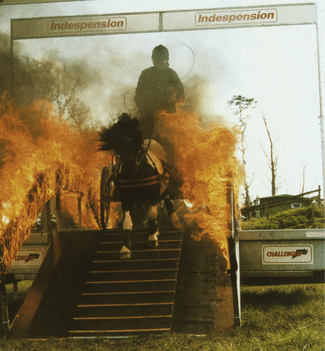
Figure 4.4 Stunt pony, Mr Pie, galloping through fire.
(Photograph courtesy of Amanda Saville-Weeks.)
Habituation is central to horse taming and pivotal in early handling regimens. Recent work by Jezierski et al23 using Konik horses, confirms that habituation to handling can reduce reactivity. Konik horses are a primitive breed unlikely to have been selected to be easily managed by humans.35 Horses exposed to daily handling (10 minutes per day over 5 days per week) from 2 weeks of age displayed a reduced heart rate and enhanced manageability compared with horses born and reared up to weaning age in a forest environment free from human contact.23 The early handling intervention made horses much easier to manage than non-handled foals in a variety of tests given at 6, 12, 18 and 25 months. Again, it pays to consider the extent of any moderating influence from these foals’ dams, that were exposed to humans as part of the experimental procedure.
Desensitization and counter-conditioning
If, rather than simply habituating horses to aversive stimuli, we expose them to pleasant coincidental consequences, counter-conditioning may occur. This helps to facilitate the emergence of an alternative, more appropriate response to the aversive stimulus. Despite encouraging data to support the use of this approach,36 this is a sadly under-exploited strategy in the management of horse behavior. Any veterinarian who appreciates the motivation most equids have to feed should be able to harness this drive to train appropriate behaviors. For example, if one is required to administer eye drops to a horse one can either struggle with it as it wrestles its head away or condition an appropriate head posture using food. The principles of learning theory that apply when horses learn to tilt their heads to nuzzle in the pockets of owners and find titbits can be used for veterinary purposes. For sustained performance, the rewards must outweigh the costs and, because horses learn to avoid aversive stimuli more than some other domestic species such as the dog,37 this means that the daily value of the reinforcements must eclipse the aversiveness of the total daily dose of eye drops. Unfortunately, for some veterinarians and owners, simple habituation to periorbital palpation is too time consuming and therefore counter-conditioning holds even less appeal. Because they are reliable sources of ocular discomfort, these are the people whom equine ophthalmic patients learn to avoid.
It is important to recognize that simply offering food in the presence of a fear-eliciting stimulus is an inadequate approach since the horse may be chewing a mouthful of food and therefore gaining gratification from it while demonstrating a flight response. Rather than allowing the fearful horse to stuff his head into a bucket of grain during exposure, a simple gratifying distraction, effective trainers use valuable rewards that are small enough to be consumed quickly. These rewards are used when the horse that tends to run away with an elevated head posture offers approximations of a more appropriate response such as turning towards the stimulus and lowering its head.38 By waiting for the horse to offer the appropriate response rather than forcing it to ‘behave’ with aversive stimuli, such as buccal discomfort where rein pressure is used, the trainer allows the horse to learn the consequences of its own actions in bringing about a reward. This elegant approach, which allows the horse to have some control over the situation, requires all the features of good training practice, including sensitive shaping technique (see p. 96) and, above all, consistency.39
A less sophisticated approach to fearfulness in horses that may, at first glance, seem expeditious, is flooding, which involves the over-exposure to the causative stimuli until the response disappears. A familiar example of flooding is seen in traditional horse ‘breaking’ when a saddle is strapped to a naïve horse that is then allowed to buck in an attempt to rid itself of the saddle until it gives up. Driven by the belief that the horse is not responding because it is no longer fearful, many misguided handlers reach for this approach to all manner of fear-elicting stimuli. Unfortunately the horse has no control over the situation and can learn that it is simply helpless to respond. Where this learning is context specific (see below), the lessons are only partially learned and the horse may emerge with extreme fear responses in slightly different circumstances. Trainers of police horses generally do not use flooding because the horses must offer learned responses in a very wide variety of contexts (see case study at the end of the chapter). Flooding in combination with physical restraint and muscle relaxants such as succinylcholine chloride has been described, with warnings about the dangers of the subjects damaging themselves as they struggle or collapse to the ground.40 Flooding that leads to apathy may be justified in certain aggressive horses, as an alternative to euthanasia, but for some it remains questionable on welfare grounds.
Associative learning
Classical conditioning
Pavlov had spotted his experimental dogs salivating when they heard his technician tinkling a bell as he approached the kennels to feed them. To determine how accurately a dog could develop such associations, Pavlov decided to replace the sound of the bell with more easily varied sounds made by a buzzer (and later a metronome). He surgically implanted a tube to collect saliva from each dog to measure its rate of production (Fig. 4.5). Pavlov used this apparatus to demonstrate the strength of the links between a novel stimulus (the buzzer), to a physiological stimulus (food in the mouth) and a response (salivation). The dogs quickly began to salivate in response to the buzzer, a new stimulus that had previously been irrelevant or neutral. The labels Pavlov created for the elements in this process are still used today. Before the learning experience, only meat powder, the unconditioned stimulus (US), produced salivation as an unconditioned response (UR) (Fig. 4.6). After learning, the buzzer became a conditioned stimulus (CS) and the salivation response to the conditioned stimulus became the conditioned response (CR, also known as the learned response).
Crucially, in classical conditioning, the sound of a buzzer was followed by the delivery of food to the mouth, regardless of what the dog might have done when it heard the buzzer. Classical conditioning enables the animal to associate events over which it has no control. This increases the predictability of an environment. The more frequently and consistently the neutral stimulus is paired with the unconditioned stimulus, the more rapidly the association will be made. In some cases, usually involving the most fundamental pain or pleasure, the association is formed with a single experience.41 We know that fear-related responses are particularly resistant to extinction42 and that single-trial learning of flight responses can persist for years.43
A good example comes from horse-breeding units. Learning about sex seems especially likely as a consequence of classical conditioning. Some stallions get aroused when they hear the sound of the bridle used to control them in the service pen. Their excitement increases when they are led to the service barn – hence, through classical conditioning another reliable environmental cue becomes associated with copulation. Racetrack grooms use classical conditioning when they whistle each time they see their charges urinating. Once the association between the whistling and urination is made, the horses urinate on cue for post-race urine tests (see Ch. 9). Riders use classical conditioning when they replace pressure cues from the bit and the rider’s legs with previously neutral signals such as changes in their position (seat).
Operant conditioning
An operant response is a voluntary activity that brings about a reward. In operant conditioning, the buzzer might still be presented but the dog must make a particular response before food is consumed. In other words, there is a special link (what learning theorists call a contingency) between a particular behavioral response and a food reward. Operant conditioning underpins most of the techniques that work well in equestrian contexts (Fig. 4.7).
While Pavlov was concentrating on the physiological responses of dogs in harnesses, Thorndike44 was studying the behavioral responses of cats in puzzle boxes. Instead of delivering food independently of behavior whenever a signal had been presented, Thorndike delivered it once his animals had responded. In a body of work intended to discredit the notion that animals are capable of reason, Thorndike44 described the behavior of a naïve cat in a specially designed box (Fig. 4.8).
Without any food or other home comforts, life was rather dull and unsustainable in the puzzle box. The cat could get out – but only by pulling a trigger. Motivated to access food outside the box, Thorndike’s cats would eventually learn to escape by operating the trigger that released the door latch. Once out of the box, they would get their food. Thorndike called this trial-and-error learning, but this label has largely been replaced by the terms instrumental learning and operant conditioning. The animal sees a cue (the trigger), performs a response (pulling) and gets a reward (liberty and food). In any horse-training or retraining situation, trainers should challenge themselves to be clear about the horse’s perception of the same three critical elements: cue, response and reward.45 The effect of the reward is to strengthen the correct response. This is known as reinforcement. The term reinforcement refers to the process in which a reinforcer follows a particular behavior so that the frequency (or probability) of that behavior increases.
On successive occasions in his free-operant studies (see below), Thorndike noted that the cat’s latency to escape fell but only very gradually. The absence of a sudden drop in the latency to learn was sufficient evidence for Thorndike to assert that his cats were not using thought or reason to solve the problem. Thorndike’s work was followed by that of Skinner,46 who maintained that almost any response could be learned by an animal that is given opportunities to operate within its environment to obtain a desired outcome.
Rocky, the 8-year-old Irish Draft horse in Chapter 1 (see Fig. 1.12), learned within 4 weeks of being at a new home that unlocking the bolt on his stable door allowed him to enrich his environment. He learned that the behavior had a pleasant result. However, he does not attempt to escape if a chain is slung across the threshold of his doorway and loosely tied with a single strand of twine. It appears that the open door affords him a better view and, for the time being at least, satisfies his motivation to observe the activity on the yard.
Operant or instrumental conditioning consists of presenting or omitting some reward or punishment when the animal makes a specific response.47 The likelihood of an association arising depends on the relationship between the first event and the second via stimulus–response–reinforcement chains. Operant conditioning enables an animal to associate events over which it has control. This increases the controllability of the environment, which represents the crucial difference between classical (Pavlovian) and operant conditioning. Operant conditioning can have potential benefits for horse welfare by improving choice. In classical conditioning, rewards become associated with stimuli, while in operant conditioning they become associated with responses.
Operant conditioning has been studied experimentally in two types of situations: ‘discrete trial’ situations and ‘free operant’ situations. In a ‘discrete trial’ situation, a subject is exposed to the learning task, required to make a response, and then withdrawn from the situation. For example, a horse may have to choose one of two directions, left or right, in a simple T-maze. In a ‘free operant’ situation, on the other hand, the subject is allowed to operate freely on its environment. For example, a horse placed in a paddock and free to do whatever it likes, can be conditioned by reinforcement under a given set of contingencies. Horses such as those that open their stable doors or dunk their own hay are good examples of free-operant conditioning. Like Thorndike’s cats and the rats that pressed levers in Skinner’s laboratory, they work within their environment to effect a reward. In equine contexts, there are many examples of individuals acquiring a response to avoid an aversive outcome. Several studies suggest that lack of control over aversive events can bring about major behavioral and physiological changes. For example, after being exposed to uncontrollable electric shocks, rats have increased gastric ulceration, increased defecation rates and are more susceptible to certain cancers when compared with individuals that retain control over comparable shocks.
Operant devices can be used to determine the preference animals have for certain environmental parameters. Horses have been trained to break photoelectric beams to turn on lighting in their accommodation and, using this device, have demonstrated a preference for an illuminated environment.48 Others have been trained to nuzzle buttons to access resources (Fig. 4.9).
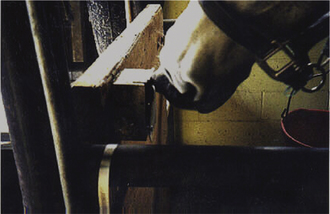
Figure 4.9 Horse performing an operant task: pressing a button with its muzzle.
(Photograph courtesy of Katherine Houpt.)
Conditioned horses have been used to study the effects of psychotropic pharmaceuticals. In one example, horses were trained to interrupt a light beam for a reward of oats.49 They developed their own individual response rates, which remained stable at between 5 and 35 responses per minute for each horse over a period of months. Reserpine (5 mg/ horse, i.v.) depressed the response rate in all horses tested. This depression was maximal between 3 and 5 days after treatment and lasted for up to 10 days. In part, the lasting nature of the drug accounts for its appeal to those seeking to modulate equine flight responses, especially during traditional breaking (2.5–10 mg s.i.d. or b.i.d. orally for up to 30 days50) (see also Ch. 3).
Training and behavior modification
In training horses we have exploited their need as prey animals to avoid discomfort and, for that matter, threats of discomfort.37 Crudely speaking, we apply pressure to attain the desired response and remove it when we get the desired response. The aim of training is to install signals (cues) that result in predictable behavior patterns. When the association between pressure, response and timely release becomes highly predictable, a habit emerges. If a habit does not develop, it could be that the animal has learned that there is no response that can reliably cause the pressure to be released. This may reflect inconsistency on the part of trainers. Unfortunately, it is possible to identify many horses in all spheres of ridden and draft work that have developed such learned helplessness and are often labeled ‘stubborn’ (see Ch. 13).51
The ability of horses to learn is one reason humans find them useful and valuable.47 The changing role of the horse demands a greater emphasis on humane treatment and the development of more sophisticated research into horse education.45 In this context, veterinarians and equine scientists can play an important role as innovators countering traditional horse-lore that resists technological advances.52
Training naïve animals is generally preferable to training animals with inappropriate experience.53 If an animal is pre-exposed to a conditioned stimulus for a number of trials before structured conditioning commences, i.e. before reinforcement, the acquisition of a conditioned response to that stimulus will be retarded. The animal has simply learned to ignore the stimulus because it has no important consequences.
Stay updated, free articles. Join our Telegram channel

Full access? Get Clinical Tree


